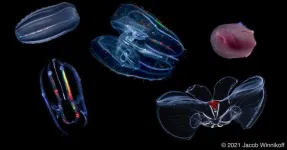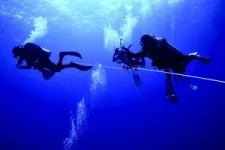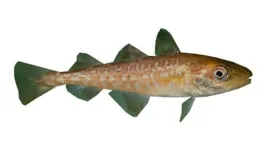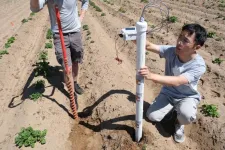(Press-News.org) The bottom of the ocean is not hospitable: there is no light; the temperature is freezing cold; and the pressure of all the water above will literally crush you. The animals that live at this depth have developed biophysical adaptations that allow them to survive in these harsh conditions. What are these adaptations and how did they develop?
University of California San Diego Assistant Professor of Chemistry and Biochemistry Itay Budin teamed up with researchers from around the country to study the cell membranes of ctenophores (“comb jellies”) and found they had unique lipid structures that allow them to live under intense pressure. Their work appears in Science.
Adapting to the environment
First things first: although comb jellies look like jellyfish, they are not closely related. Comb jellies comprise the phylum Ctenophora (pronounced tee-no-for-a). They are predators that can grow as large as a volleyball and live in oceans all over the world and at various depths, from the surface all the way down to the deep sea.
Cell membranes have thin sheets of lipids and proteins that need to maintain certain properties for cells to function properly. While it has been known for decades that some organisms have adapted their lipids to maintain fluidity in extreme cold — called homeoviscous adaptation — it was not known how organisms living in the deep sea have adapted to extreme pressure, nor whether the adaptation to pressure was the same as the adaptation to cold.
Budin had been studying homeoviscous adaptation in E. coli bacteria, but when Steven Haddock, senior scientist at the Monterey Bay Aquarium Research Institute (MBARI), asked whether ctenophores had the same homeoviscous adaptation to compensate for extreme pressure, Budin was intrigued.
Complex organisms have different types of lipids. Humans have thousands of them: the heart has different ones than the lungs, which are different from those in the skin, and so on. They have different shapes too: some are cylindrical and some are shaped like cones.
To answer whether ctenophores adapted to cold and to pressure through the same mechanism, the team needed to control the temperature variable. Jacob Winnikoff, the study’s lead author who worked at both MBARI and UC San Diego, analyzed ctenophores collected from across the northern hemisphere, including those that lived at the bottom of the ocean in California (cold, high pressure) and those from the surface of the Arctic Ocean (cold, not high pressure).
“It turns out that ctenophores have developed unique lipid structures to compensate for the intense pressure that are separate from the ones that compensate for intense cold,” stated Budin. “So much so that the pressure is actually what’s holding their cell membranes together.”
The researchers call this adaptation “homeocurvature” because the curve-forming shape of the lipids has adapted to the ctenophores’ unique habitat. In the deep sea, the cone-shaped lipids have evolved into exaggerated cone shapes. The pressure of the ocean counteracts the exaggeration so the lipid shape is normal, but only at these extreme pressures. When deep-sea ctenophores are brought up to the surface, the exaggerated cone shape returns, the membranes split apart, and the animals disintegrate.
The molecules with an exaggerated cone shape are a type of phospholipid called plasmalogens. Plasmalogens are abundant in human brains and their declining abundance often accompanies diminishing brain function and even neurodegenerative disease like Alzheimer’s. This makes them very interesting to scientists and medical researchers.
“One of the reasons we chose to study ctenophores is because their lipid metabolism is similar to humans,” stated Budin. “And while I wasn’t surprised to find plasmalogens, I was shocked to see that they make up as much as three-quarters of a deep-sea ctenophore’s lipid count.”
To further test this discovery, the team went back to E. coli, conducting two experiments in high-pressure chambers: one with unaltered bacteria and a second with bacteria that had been bioengineered to synthesize plasmalogens. While the unaltered E. coli died off, the E. coli strain containing plasmalogens thrived.
These experiments were conducted over the course of several years and with collaborators across multiple institutions and disciplines. At UC San Diego, in addition to Budin, whose group conducted the biophysics and microbiology experiments, Distinguished Professor of Chemistry and Biochemistry Edward Dennis’s lab conducted lipid analysis by mass spectrometry. Marine biologists at MBARI collected ctenophores to study, while physicists at the University of Delaware ran computer simulations to validate membrane behaviors at different pressures.
Budin, who is interested in studying how cells regulate lipid production, hopes this discovery will lead to further investigations into the role plasmalogens play in brain health and disease.
“I think the research shows that plasmalogens have really unique biophysical properties,” he said. “So now the question is, how are those properties important for the function of our own cells? I think that’s one takeaway message.” This
Full list of authors: Daniel Milshteyn, Edward A. Dennis, Aaron Armando, Oswald Quehenberger and Itay Budin (all UC San Diego); Jacob R. Winnikoff (Harvard University); Sasiri J. Vargas-Urbano, Miguel Pedraza and Edward Lyman (all University of Delaware); Alexander Sodt (National Institute of Child Health and Human Development); Richard E. Gillilan (Cornell University); and Steven H.D. Haddock (MBARI).
This research was supported through grants by the National Science Foundation, the National Aeronautics and Space Administration, the National Institutes of Health, the Office of Naval Research, and the David and Lucile Packard Foundation.
END
Under pressure: How comb jellies have adapted to life at the bottom of the ocean
Research shows deep sea organisms have unique lipid structures to help them survive
2024-06-27
ELSE PRESS RELEASES FROM THIS DATE:
A CHARMed collaboration created a potent therapy candidate for fatal prion diseases
2024-06-27
EMBARGOED UNTIL 27-Jun-2024 14:00 ET
Drug development is typically slow: the pipeline from basic research discoveries that provide the basis for a new drug to clinical trials to production of a widely available medicine can take decades. But decades can feel impossibly far off to someone who currently has a fatal disease. Broad Institute Senior Group Leader Sonia Vallabh is acutely aware of that race against time, because the topic of her research is a neurodegenerative and ultimately fatal disease–fatal familial insomnia, a type of prion disease–that she will almost certainly develop as she ages. Vallabh and her husband, Eric Minikel, switched careers ...
Researchers find flexible solution for separating gases
2024-06-27
For a broad range of industries, separating gases is an important part of both process and product—from separating nitrogen and oxygen from air for medical purposes to separating carbon dioxide from other gases in the process of carbon capture or removing impurities from natural gas.
Separating gases, however, can be both energy-intensive and expensive. “For example, when separating oxygen and nitrogen, you need to cool the air to very low temperatures until they liquefy. Then, by slowly increasing the temperature, the gases will evaporate at different points, allowing one to become a gas again and separate out,” explains Wei Zhang, a University of Colorado Boulder professor ...
Pacific cod can’t rely on coastal safe havens for protection during marine heat waves, OSU study finds
2024-06-27
During recent periods of unusually warm water in the Gulf of Alaska, young Pacific cod in near shore safe havens where they typically spend their adolescence did not experience the protective effects those areas typically provide, a new Oregon State University study found.
Instead, during marine heat waves in 2014-16 and 2019, young cod in these near shore “nurseries” around Kodiak Island in Alaska experienced significant changes in their abundance, growth rates and diet, with researchers estimating that only the largest 15-25% of the island’s cod population survived the summer. Even after the high temperatures subsided, the ...
Bird flu stays stable on milking equipment for at least one hour
2024-06-27
Bird flu, or H5N1 virus, in unpasteurized milk is stable on metal and rubber components of commercial milking equipment for at least one hour, increasing its potential to infect people and other animals, report researchers from the University of Pittsburgh School of Medicine and Emory University in Emerging Infectious Diseases.
The study underscores the heightened risk of bird flu exposure for dairy farm workers and signals the need for wider adoption of personal protective equipment, including face shields, masks and eye protection.
“Dairy cows have to be milked even if they are sick, and it has not been clear for how long the virus contained in residual milk from the ...
Printed sensors in soil could help farmers improve crop yields and save money
2024-06-27
MADISON — University of Wisconsin–Madison engineers have developed low-cost sensors that allow for real-time, continuous monitoring of nitrate in soil types that are common in Wisconsin. These printed electrochemical sensors could enable farmers to make better informed nutrient management decisions and reap economic benefits.
“Our sensors could give farmers a greater understanding of the nutrient profile of their soil and how much nitrate is available for the plants, helping them to make more precise decisions on how much fertilizer they really need,” says Joseph Andrews, an assistant professor of mechanical ...
Neighborhood opportunities influence infant development and cognition
2024-06-27
Growing up in neighborhoods with more educational and socioeconomic opportunities has a positive impact on infants’ brain activity, according to new research from Boston Medical Center (BMC). The study, published in The Journal of Developmental & Behavioral Pediatrics, suggests that enhancing neighborhood opportunities, particularly in education, can be a promising approach to promoting early childhood development.
A team of early childhood researchers examined how neighborhood opportunity – the socioeconomic, educational, health, and ...
New twists on tornadoes: Earth scientist studies why U.S. has so many tornadoes
2024-06-27
WEST LAFAYETTE, Ind. — Across the Midwest during the warmer months, studying the sky for signs of storms and tornadoes becomes one of the most popular pastimes.
Dan Chavas, an associate professor in the Department of Earth, Atmospheric, and Planetary Sciences at Purdue University’s College of Science, takes it further: All day every day, he studies what makes tornadoes tick. Working at the intersection of climate science and meteorology, he looks at the big picture of what causes severe storms and tornadoes — and what dictates where ...
Children’s Hospital of Philadelphia researchers find elementary age children experience more concussions during activities unrelated to sports
2024-06-27
Philadelphia, June 27, 2024 – Researchers from Children’s Hospital of Philadelphia (CHOP) found that young children between the ages of 5 and 12 were more likely to experience a concussion from recreation and other non-sport activities, yet those injuries were not seen by specialists until days later compared with sports-related concussions in the same age group.
This study suggests concussion research is needed for children outside of sports and that providing more resources and education ...
Ultrasounds may not find this cancer in Black women
2024-06-27
A common algorithm to check for endometrial cancer is not reliable for Black women, according to a new study published today in JAMA Oncology.
In Black patients with concerning symptoms, a tissue biopsy is strongly recommended to rule out endometrial cancer instead of using transvaginal ultrasound, the report concluded.
Endometrial cancer is the most common type of gynecological cancer in the United States. It is one of the few types of cancer now on the rise, especially among Black women, who are more likely to be diagnosed at later stages of the disease. This cancer can cause symptoms such as abnormal vaginal ...
Urban green and blue spaces are linked to less coronary artery calcification
2024-06-27
· Black participants with greater access to green spaces had up to 35% lower odds of calcification
· Black participants living near a river had 32% lower odds of calcification
· Coronary artery calcification is an early sign of cardiovascular disease
CHICAGO --- Being near and having more exposure to urban green space and blue (water) space is linked to lower odds of having coronary artery calcification in middle age, which is an early marker of cardiovascular disease.
The associations were more pronounced among Black individuals and those living in neighborhoods ...
LAST 30 PRESS RELEASES:
UVA’s Jundong Li wins ICDM’S 2025 Tao Li Award for data mining, machine learning
UVA’s low-power, high-performance computer power player Mircea Stan earns National Academy of Inventors fellowship
Not playing by the rules: USU researcher explores filamentous algae dynamics in rivers
Do our body clocks influence our risk of dementia?
Anthropologists offer new evidence of bipedalism in long-debated fossil discovery
Safer receipt paper from wood
Dosage-sensitive genes suggest no whole-genome duplications in ancestral angiosperm
First ancient human herpesvirus genomes document their deep history with humans
Why Some Bacteria Survive Antibiotics and How to Stop Them - New study reveals that bacteria can survive antibiotic treatment through two fundamentally different “shutdown modes”
UCLA study links scar healing to dangerous placenta condition
CHANGE-seq-BE finds off-target changes in the genome from base editors
The Journal of Nuclear Medicine Ahead-of-Print Tip Sheet: January 2, 2026
Delayed or absent first dose of measles, mumps, and rubella vaccination
Trends in US preterm birth rates by household income and race and ethnicity
Study identifies potential biomarker linked to progression and brain inflammation in multiple sclerosis
Many mothers in Norway do not show up for postnatal check-ups
Researchers want to find out why quick clay is so unstable
Superradiant spins show teamwork at the quantum scale
Cleveland Clinic Research links tumor bacteria to immunotherapy resistance in head and neck cancer
First Editorial of 2026: Resisting AI slop
Joint ground- and space-based observations reveal Saturn-mass rogue planet
Inheritable genetic variant offers protection against blood cancer risk and progression
Pigs settled Pacific islands alongside early human voyagers
A Coral reef’s daily pulse reshapes microbes in surrounding waters
EAST Tokamak experiments exceed plasma density limit, offering new approach to fusion ignition
Groundbreaking discovery reveals Africa’s oldest cremation pyre and complex ritual practices
First breathing ‘lung-on-chip’ developed using genetically identical cells
How people moved pigs across the Pacific
Interaction of climate change and human activity and its impact on plant diversity in Qinghai-Tibet plateau
From addressing uncertainty to national strategy: an interpretation of Professor Lim Siong Guan’s views
[Press-News.org] Under pressure: How comb jellies have adapted to life at the bottom of the oceanResearch shows deep sea organisms have unique lipid structures to help them survive




